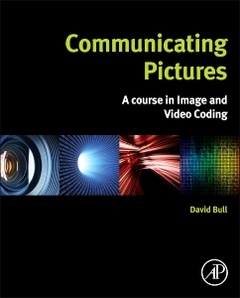Description
Communicating Pictures
A Course in Image and Video Coding
Author: Bull David
Language: English
Subjects for Communicating Pictures:
Keywords
<; p>; Communicating Pictures; Video Coding; Pictures; Image Coding; Video Compression; Image Compression; Rate-Distortion Performance; Spatial Decorrelation; Temporal Decorrelation; Hybrid block-based coding architecture; H.264/AVC; HEVC; Codec; Transmission; Streaming; Standards; Communications; Processing<; /p>; <; P>; <; /p>
Publication date: 10-2018
560 p. · 19x23.3 cm · Paperback
Replaced by new edition: Access to the new edition.
Publication date: 06-2014
560 p. · 19x23.3 cm · Hardback
Replaced by new edition: Access to the new edition.
Description
/li>Contents
/li>Readership
/li>Biography
/li>Comment
/li>
Communicating Pictures starts with a unique historical perspective of the role of images in communications and then builds on this to explain the applications and requirements of a modern video coding system. It draws on the author's extensive academic and professional experience of signal processing and video coding to deliver a text that is algorithmically rigorous, yet accessible, relevant to modern standards, and practical. It offers a thorough grounding in visual perception, and demonstrates how modern image and video compression methods can be designed in order to meet the rate-quality performance levels demanded by today's applications, networks and users.With this book you will learn:
- Practical issues when implementing a codec, such as picture boundary extension and complexity reduction, with particular emphasis on efficient algorithms for transforms, motion estimators and error resilience
- Conflicts between conventional video compression, based on variable length coding and spatiotemporal prediction, and the requirements for error resilient transmission
- How to assess the quality of coded images and video content, both through subjective trials and by using perceptually optimised objective metrics
- Features, operation and performance of the state-of-the-art High Efficiency Video Coding (HEVC) standard
Preface1. Introduction2. The Human Visual System3. Discrete-Time Analysis for Images and Video4. Digital Picture formats and Representations5. Transforms for Image and Video Coding 6. Filter Banks and Wavelet Compression7. Lossless Compression Methods8. Coding Moving Pictures: Motion Prediction9. The Block-Based Hybrid Video Codec10. Measuring and Managing Picture Quality11. Communicating Pictures: Delivery across Networks12. Video Coding Standards13. Communicating Pictures- The FutureAppendix A: Glossary of TermsAppendix B: Tutorial Problems
Video and Image processing R&D engineers, wireless and networking engineers; undergraduate and postgraduate students taking a course in image and video coding.
David has worked widely across image and video processing focused on streaming, broadcast and wireless applications. He has published over 600 academic papers, various articles and 4 books and has given numerous invited/keynote lectures and tutorials. He has also received awards including the IEE Ambrose Fleming Premium for his work on Primitive Operator Digital Filters and a best Paper Award for his work on Link Adaptation for Video Transmission. David’s work has been exploited commercially and he has acted as a consultant for companies and governments across the globe. In 2001, he co-founded ProVision Communication Technologies Ltd., who launched the world’s first robust multi-source wireless HD sender for consumer use. His recent award-winning and pioneering work on perceptual video compression using deep learning, has produced world-leading rate-quality performance.
- Covers the basics of video communications and includes a strong grounding in how we perceive images and video, and how we can exploit redundancy to reduce bitrate and improve rate distortion performance
- Gives deep insight into the pitfalls associated with the transmission of real-time video over networks (wireless and fixed)
- Uses the state-of- the-art video coding standard (H.264/AVC) as a basis for algorithm development in the context of block based compression
- Insight into future video coding standards such as the new ISO/ITU High Efficiency Video Coding (HEVC) initiative, which extends and generalizes the H.264/AVC approach




